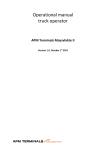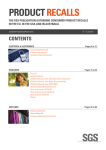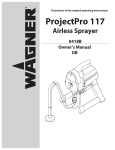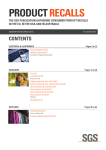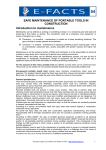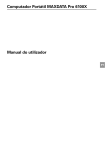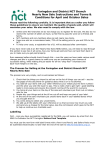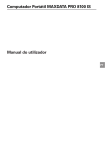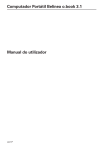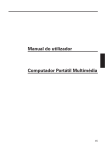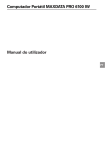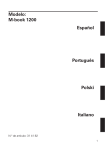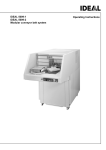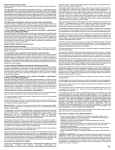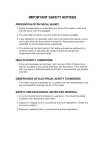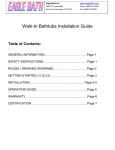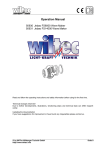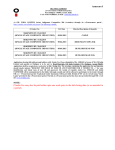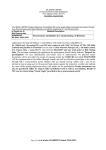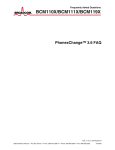Download Stationary and Portable Spas Important Safety Information
Transcript
Stationary and Portable Spas Important Safety Information Impression of an example of such a product Following a number of complaints received by European Market Surveillance Authorities and resulting investigations it has been identified that there are substantial problems with a number of spas, in particular stationary spas, available on the European market. The problems identified include, but are not limited to: Unsafe due to poor instruction as to how to safely connect to the power supply; Being of class II construction but with inadequate insulation; o Insulation failures can lead to live parts coming into contact with water; o Failure of the heating element (tubes) lead to live parts of the heating element coming into direct contact with water; Live parts can come into contact with water; Inadequate instructions and labels for putting into use. Recommendation Manufacturers and Importers are responsible for the safety of the products and should ensure that their products comply with the safety legislation and that under reasonable foreseeable use and taking into consideration of normal degradation with use and aging, including failure of components, that the products remain safe. The instructions for use and labelling must be clear to consumers and in particular address separation distances (zone requirements). Distributors and retailers should satisfy themselves that the products they are handling are intended for their market and have clear instructions as to how the product should be put into service. Further Information Details of some recent incidents and some suggested conditions are provided in the following documents1. 1 Recommendation of the LVD ADCO Group - 30 January 2015 including the enclosed Annex LOW VOLTAGE DIRECTIVE (LVD) – DIRECTIVE 2006/95/EC Recommendation of the LVD ADCO Group - 30 January 2015 Introduction Member States Market Surveillance Authorities of LVD AdCo have found that several spas, either stationary or portable (equipment which can be easily relocated for indoor or outdoor use, but excluding construction products subject to Directive 89/106/EEC), did not fully comply with the essential safety requirements for electrical equipment within the scope of the Low Voltage Directive (LVD 2006/95/EC, Annex I). It became clear that the safety deficiencies were not restricted to the investigated spas and similar products only and that lacks in the applicable standard EN 60335-2-60, bad interpretation of that standard induced by unclear requirements and/or discrepancies between requirements in this and other involved standards are a probable cause. One of the Member States followed the procedure leading to a GPSD RAPEX article 12 notification and a notification according to the procedure of article 9 of the LVD including notifying a lack in standard EN 60335-2-60 Particular requirements for whirlpool baths and whirlpool spas. In addition that particular Member State started a formal objection against the harmonised standard EN 60335-2-60 following Regulation (EU) No 1025/2012 on European standardisation. The involved CENELEC standardisation committees have not taken positions yet. This was discussed at the 19th meeting of the Low Voltage Directive (2006/95/EC) Working Party (LVD WP) on 28th October 2014 and the 34th meeting of the LVD Administrative Cooperation working group (LVD AdCo) 29th and 30th October 2014. It has to be ensured that electrical equipment can be placed on the market only, if they have been designed and manufactured in accordance with safety requirements in force in the Community and that it does not endanger the safety of persons, domestic animals or property when properly installed and maintained and used, in applications for which it was made. Regarding the spas, the essential safety requirements LVD can be achieved by following the product standard EN 60335-2-60 provided that the lack in the standard reported by the LVD ADCO, the national wiring rules (normally based on the Harmonization Document HD 60364 series2; in particular, HD 60364-7-702, for this kind of products) and this recommendation are taken into account. The discussion during the LVD AdCo meeting made clear that full compliance with those standards is considered necessary, but might be difficult to achieve; especially regarding the zone requirements. For that reason it can be concluded that manufacturers will not be able to meet all requirements of the applicable product standard unless the national wiring installation rules are also complied with for the product to be used safely. 2 - EN 60335-2-60:2003 Household and similar electrical appliances - Safety - Part 2-60: Particular requirements for whirlpool baths and whirlpool spas + A1:2005 + A2:2008 + A11:2010 + A12:2010; - EN 60335-1:2012 (or EN 60335-1: 2002) Household and similar electrical appliances – Safety Part 1: General requirements as described in the foreword of part 2-60; - HD 60364-1:2008 - Low-voltage electrical installations - Part 1: Fundamental principles, assessment of general characteristics, definitions (IEC 60364-1:2005, modified) as implemented in the national wiring rules; - HD 60364-4-41:2007 - Low-voltage electrical installations - Part 4-41: Protection for safety - Protection against electric shock - HD 60364-7-702: 2010 Low-voltage electrical installations – Requirements for special installations or locations – Swimming pools and fountains as implemented in the national wiring rules; - (and as far as relevant EN 60335-2-41 Household and similar electrical appliances - Safety - Particular requirements for pumps for reference). At the 34th meeting of LVD AdCo the following was unanimously agreed by the Member States present: A Working Group of LVD AdCo would work out a recommendation valid for the period of 12 months with possible measures aimed to incorporate in constructions of spas and similar products and some compromises regarding the zone requirements based on the HD 60364, under the condition that the proposed compensating measures contribute to obtaining the required safety level of the standards and the Directive as closely as possible. This LVD AdCo recommendation serves only to resolve a particular existing problem in a given situation and cannot be used to design new applications or innovative products. Therefore it is valid for a limited period (with the possibility to extend the period if necessary) only until the new standard is in place. Instead of some of the strict zone requirements and to obtain the required safety level as closely as possible, it is recommended that manufacturers take into account the following: – Provisons are made to ensure that, in case the bathing water comes into contact with live parts, persons in contact with the water will be adequately protected against electric shock for any foreseeable use. A 30 mA residual current device (RCD) in the supply cord is not considered to be sufficiently suitable for that purpose, because in these areas, in normal use, the effect of an electric shock is increased by a reduction in body resistance and contact of the body with earth potential. – In order to respect the requirements of the protection against electric shock by indirect contact, the constructions shall be such that in the unlikely event that the bathing water comes into contact with live parts, the installation will automatically be disconnected from the supply as required for the protection against indirect contact. – In particular and in order to prevent that heating elements at a first defect make contact between live parts and the bathing water, the internal construction of heating elements shall be such that the protection offered is double insulation. – If tube elements are used it must be ensured that during the lifetime of the spa the heating element cannot be detoriorated by corrosion or other adverse incidents that can result in a defect and contact between live parts and the bathing water. – Those parts of the construction that can operate at safety extra low voltage (SELV) or protective extra low voltage (PELV) shall be designed and manufactured as to be operated at SELV or PELV. Only if there are design and constructional obstacles, like high power consumption components, direct connection to the mains supply can be considered as an option. For example if the protection against electric shock is obtained by electrical separation and a complementary measure like the use of a RCD. – If an electrical unit pertaining to the product is placed directly connected close to the spa without respecting the zone requirements, the IP classification shall be adequate and be based on the wiring rules requirements for this zone. – The requirements for the correct zone for the connection to the mains supply shall be respected and be included in the user manual and as a warning visible during each installation of the construction. – Of course, all other relevant requirements of the standards shall be taken into account. Manufacturers, in order to be able to comply with the safety objectives for electrical equipment within the scope of the Low Voltage Directive (LVD 2006/95/EC, Annex I), can use the requirements of the relevant product standard EN 60335-2-60, taking into account the by LVD AdCo reported lack in the standard, and combined with the national wiring rules, which are normally established in base of HD 60364 series (in particular HD 60364-4-41 and in addition HD 60364-7-702) and taking into account this LVD AdCo recommendation. Because the LVD AdCo recommendation makes it easier for manufacturers to design their products the LVD AdCo recommendation can be applied immediately after its publication. This LVD AdCo recommendation does not change the application of the Low Voltage Directive nor the National wiring rules in any respect and aims only to provide some practical information for manufacturers and economic operators for a specific situation. This LVD AdCo recommendation does not change the application of the standards in relation to the Low Voltage Directive nor the National wiring rules in any respect and does not aim or provide a new set of technical requirements that cover a claim on presumption of conformity or of compliance with the essential safety requirements of the Low Voltage Directive. For that reason this LVD AdCo recommendation is only applicable for a certain period. Before the period of 12 months for the application of this LVD AdCo recommendation is over. It is expected that CENELEC TC61 and 64 can provide more clarity on the correct application of the requirements in the respective standards as soon as possible. The administrative requirements of the LVD must be respected, so the manufacturer must be able to present a complete technical file in order to make it possible to assess conformity of the electrical equipment to the relevant requirements. The technical file shall contain a rationale for decisions made by the manufacturer. The safety of the product remain the sole responsibility of manufacturers and economic operators. The aim of this LVD AdCo recommendation is to provide clarification for the situation for Market Surveillance Authorities in dealing with products which, although complying with the applicable harmonised standards, do not comply fully with the essential safety requirements of the LVD. However, in light of investigations and failures found with the products in question, the LVD ADCO’s view is that the applicable standard does not adequately address the safety requirements of the LVD and Member States have raised their concerns with the European Commisson. Annex 1 belonging to the LVD AdCo Recommendation for the spa case Inflatable spa (and similar products) Introduction To the national Authorities in the Netherlands are two accidents reported and investigations of the accidents made clear that the appliance was classified as class II for connection to the mains power supply. In time the manufacturer used several versions of the heating element. The heating element of the involved first (known) generation does not comply with the safety requirements for class II. At a first defect the bathing water in the spa can come directly into contact with dangerous tensional parts of the heating element that operates and is connected to the mains power supply (230 volt). The heating element of the second generation does come closer to a class II construction. However, the investigation of the accident showed that by the application of this element also at a first defect the bathing water in the spa can come into contact with the mains power supply (230 volt). Investigation showed that defects are probably caused by mechanical stress during manufacturing of the heating element. First accident The spa involved in the incident: The person involved reported that by touching the ground by leaving the spa he received a severe electric shock. He laid down on the ground suffering severe muscle cramping all over his body. After some time he recovered and was able to function again. He reported that the RCD in the plug and in the household installation were not activated at the accident. Verification by investigation learned that the RCD in the plug afterwards operated by testing with a simulated leakage current. Technical investigation showed that the heating element in the electrical unit was ruptured and that the dangerous (230 volt) tensional parts came directly into contact with the water in the spa. Investigators concluded that the accident is caused by the defect of the heating element. We concluded that the heating element is not suitable for this purpose. Second accident Very recently another accident happened, similar to the previous one, and with the same spa serie. This spa was sold to the user about 1,5 month ago. It was provided with the first (known) improved heating element. The twelve year old son of the family wanted to use the spa and put the plug into the wall socket with approval of his father. In supervision of his father warm water was added into the spa to reach the correct level for filling. The son touched the water and felt some tingling experience. He told his father and he responded that it was not possible that the water was in contact with the mains. In order to check he put his hand in the water and felt surprisingly the tingling himself and concluded that it was probably caused by static electricity due to the filling with water. After about one minute the father touched the water again and suffered a severe electric shock following his saying. The son found it funny and thought his father was joking and put his hand in the water. The father reported that the whole body of his son shocked. Both RCD (in the plug of the spa and the household electric installation) did not react was stated. Verification by investigation learned that both RCD afterwards operated by testing with a simulated leakage current. Technical investigation showed that the heating element in the electrical unit was of a very different model than involved in the first accident. It showed that the dangerous (230 volt) tensional parts came into contact with the metal casing of the housing of the element. That metal casing is in direct contact with the water in the spa. Investigators concluded that the accident is caused by the defect of the heating element. We concluded that the heating element is not suitable for this purpose. The dealers have information that this happened more often with both type of elements, only there was less harm in those cases; which seems to be a matter of luck. In the mean time we also received information on similar accidents in other member states and a recall of a spa likely based on similar defects (recall in 23-04-2014 in Australia. The reported reason for the recall was similar to the causes of the accidents in the Netherlands; https://www.recalls.gov.au/content/index.phtml/itemId/1058037). The design of the element and certification The non-compliance of the product is clear and a warning to end users, a recall, a GPSD RAPEX notification article 12 and a notification accordingly to article 9 Low Voltage Directive (LVD) was considered essential in order to try to prevent any further accidents. The Netherlands Food and Consumer Product Safety Authority (NVWA), the responsible national Market Surveillance Authority investigated the two reported accidents. Based on the received information that the heating element involved in the first accident was not separately classified as a class II component, but that it was only tested for compliance together with the appliance. That is allowed under the condition that all relevant aspects (e.g. high voltage test, creepage and clearance distances and construction) are fully taken into account. However, spirals of heating elements within a metal tube and placed in water cannot be considered to comply with class II. It is commonly known that due to corrosion or at the and of life of the element it can rupture and the main voltage can come directly into contact with the bathing water. The heating element of the involved second (known) generation showed, by technical investigation, that defects are probably caused by mechanical stress during manufacturing of the heating element. Due to a number of incidents and other information it is most likely that the original isolation barriers in the heating element are damaged and the metal housing, that is in contact with the water, connect to the mains supply (230 V). The manufacturer has for a certain time changed the design and (probably to prevent further incidents and accidents) brought and electrical connection from the metal casing of the heating element to contact points in two feet of the electrical unit (probably to create a connection to earth). In that case the product cannot be classified as class II any longer, but is neither complying with class I construction. See for references EU: Low Voltage Directive 2006/95/EC LVD: article 2, Annex I , part 1, clause d, and part 2, clause a and/or d In the notification following the article 9 procedure is included that a non-conformity with Article 2 of the low Voltage Directive resulting from a shortcoming in the applicable standard(s) is reported. The following standards have to be taken in consideration: EN 60335-2-60:2003 Household and similar electrical appliances - Safety - Part 2-60: Particular requirements for whirlpool baths and whirlpool spas + A1:2005 + A2:2008 + A11:2010 + A12:2010; EN 60335-1:2002 EN 60335-1: 2002 Household and similar electrical appliances – Safety Part 1: General requirements as described in the foreword of part 2-60; HD 60364-1:2008 - Low-voltage electrical installations - Part 1: Fundamental principles, assessment of general characteristics, definitions (IEC 60364-1:2005, modified) as implemented in the national wiring rules; IEC 60364-7-702: (ed 3.0) Low-voltage electrical installations –Requirements for special installations or locations – Swimming pools and fountains as implemented in the national wiring rules; EN 60335-2-41 Household and similar electrical appliances - Safety - Particular requirements for pumps for reference The manufacturer declared that the product is tested according the EN 60335-2-60 and certified by a (notified body) test institute. For that reason the NVWA included in the notification that that the nonconformity was resulting from a shortcoming in that standard. The accidents were only the reason to take appropriate actions. However the issue is not restricted to the product involved in the accident only. If a product cannot be used safely in its surrounding, than such product should not be placed in the market; even if they comply with a product standard. In this case the wiring rules set out requirements for swimming pools. The concerned products are comparable with swimming pools and the same requirements must be met. In earlier discussions within Authorities we considered EN 60335-2-60 not applicable for the considered products; see e.g. Information sheet LVD AdCo : “Pumps and other electrical appliances for mobile swimming pools”. http://ec.europa.eu/enterprise/sectors/electrical/documents/lvd/guidance/adco/index_en.htm In relation to spa LVD AdCo expressed their serious concerns on safety for several years now. For a longer time especially concerns are raised with regard to easy replaceable or moveable swimming pools, Whirlpools and spas. The configuration and construction of the applicable requirements for pumps and other electrical appliances for mobile swimming pools are discussed and were still not clear to economic operators. Specific standards for pumps and other electrical appliances for mobile swimming pools are not available. The information sheet published on Commission website aimed to provide more clarity for all. However, now a manufacturer and a test institute claimed that they used the EN 60335-2-60 as the applicable standard (and there are indications that they are not the only ones) the following statements have to be considered: - The wiring rules in EU member states will include the requirements of IEC 60364-7-702. Based on the requirements in that standard market surveillance authorities concluded that swimming pools (e.g. spas) with 230 volt appliances for the spa located within the zone 0 and 1 (and 2) for non fixed spas according the applicable wiring rules is considered in noncompliance with the essential safety requirements of the LVD. The accident investigations of the NVWA made painfully clear that it is necessary to comply with the relevant requirements. In par. 7.12.1 of EN 60335-2-60 is stated that one must take notice of the wiring rules. The requirement is that: The installation instructions shall give details on how to follow the wiring rules, for example, specifying that parts are installed in the correct zone and that equipotential bonding is carried out. This raise the need for clarification on the (main) questions: Why does the standard EN 60335-2-60 allows classification class II (without any further restriction). At least for the concerned certified product class II is not allowed by the wiring rules. Why is the product certified, because it is clear that the requirements of the wiring rules with regard to the applicable zones is not respected (the parts operating at 230 volt are considered to be placed in zone 0 for the concerned product). The part of swimming pools in EN 60335-2-41 is clear and seems in line with the wiring rules. It is not clear why different requirements are set out for similar conditions. In A1 of EN 60335-2-60 is the scope of the standard amended as follows: In the first paragraph, replace “whirlpool baths for indoor use” by “whirlpool baths for indoor use and whirlpool spas”. The implications of this amendment need clarification. In both known following options we noted some contradiction: When the part of the sentence should be read as: “whirlpool baths for indoor use and whirlpool spas for indoor use” the manufacturer, the test institute and many other interpreted the scope not in the way intended. When the part of the sentence should be read as: “whirlpool baths for indoor use and all whirlpool spas” it is notable that only the scope is widened to outdoor use for spa without the addition of any requirements related to the outdoor use. At least in the case of spas for outdoor use there is a contradiction in allowing class II in situations where the wiring rules do not accept such constructions. Besides this specific case, it is noticed that in EN 60335-2-60 for whirlpools the zone under the bath is not brought in relation to the existing wiring rules. If appliances/components are placed under the defined zone 0 according IEC 60364-7702 and operate at main supply (230 volt) the situation is comparable as described for the spa concerned and class II would be accepted following the requirements of EN 60335-2-60. Some clarification is needed, because the safety level as required by the wiring rules is not met in that case. We do note that the wiring rules themselves do not define especially the room underneath the zone 0, but due to application and interpretation of all requirements the zone (directly) beneath the bath must be considered as zone 0. One might conclude that - no suitable standard is existing and the used references are applied incorrect. In that case it seems necessary to inform stakeholders accordingly. Taken into account the wiring rules and in addition the other standards we conclude that appliances non fixed to the wiring installation and working at 230 volt cannot be allowed within the zones 0 (also underneath the bath) and 1 (and 2) for spas (and whirlpools). Secondly the use of such class II appliances in a surrounding where additional equipotential bonding is missing should not be allowed. Here also starts the discussions we had with stakeholders what has to be considered in this case as replaceable, stationary and fixed. Fixed has than to be divided in explaining related to constructional and electrical requirements. From the view of safety one has to conclude that replaceable and stationary electrical appliances for spas and the like can be situated easily to another location in relation to accessories/appliances and the mains. Such combinations have to be considered non-fixed. Only if the spa or the like can be considered fixed itself, the connection to the electrical installation is installed fixed to the mains and the installation instructions provide information accordingly it can be considered as a fixed installation. This is for the current products not clear or interpreted in a wrong way. In the household installation already a RCD need to be present based on the wiring rules when someone want to use a spa. This is also included in the user manual. So, an additional RCD incorporated in the plug as sometime applied does add very little or non to the level of safety. A recent German study from BAuA shows that 30 mA RCD protection is insufficient to prevent fatal accidents. A Danish study some years ago showed that the reliability of RCD cannot be ensured and that there is a rather high failure rate due to several causes. Therefore a 10 mA is considered a more appropriate addition for swimming pools and similar products. However, provisions like RCD are considered a last station of prevention and are meant never to function. It is not acceptable as a safety measure in products to cover foreseeable or expected failures of components like pumps, transformers or heating elements. At this moment the (interpretation) way how to apply standards is not clear and it seems at least that the standards are not interpreted in the same way by all stakeholders. It is very well understandable that at the moment that the relevant standards were developed novelty products were not taken into account. However, a manufacturer has the obligation to perform a risk analysis to ensure that the product can be used safely. When there are suitable harmonised standards available a part of that task is considered be done as long as the product falls within the scope of that standard. We have to bare in mind that in standards sometimes lacks are signalized. It might be that the interaction of certain requirements in standards do interfere with each other and that the high level of safety is not equally implemented in standards yet. However, if the above issues can be clarified in the existing situation it still has to be clarified whether the standards are non-conform applied by the manufacturer en the test institute. If even that is not the case, than the existing safety level guarded by the standards does not prevent very serious accidents as described and in that case it seems necessary to improve the standard(s). In general the EU Commission and member states expressed that they require a high level of safety. This means an adequate protection to ensure prevention of incidents and accidents. We consider that the clarification asked for is needed very urgently in order to prevent any further accidents and to be able to explain to all stakeholders how to comply with the requirements set out in the Low Voltage Directive and the applicable standards. The described uncertainties do not influence the measures taken by the NVWA. The accidents have made it painfully clear that necessary actions had to be taken.








